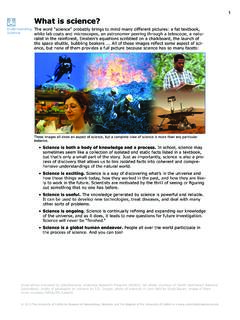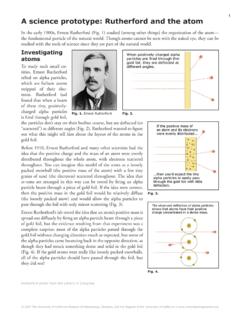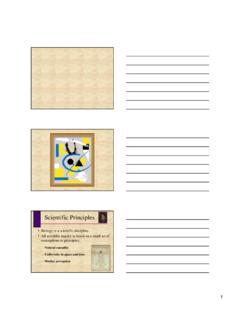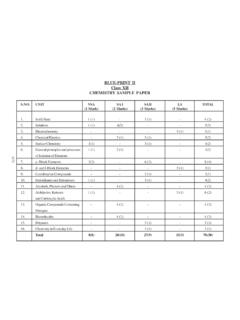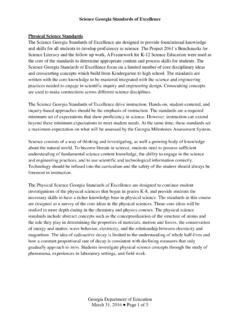Transcription of PB 1 What is science? - Understanding Science
1 2013 The University of California Museum of Paleontology, Berkeley, and the Regents of the University of California is Science ? The word Science probably brings to mind many different pictures: a fat textbook, white lab coats and microscopes, an astronomer peering through a telescope, a natu-ralist in the rainforest, Einstein s equations scribbled on a chalkboard, the launch of the space shuttle, bubbling beakers .. All of those images reflect some aspect of sci-ence, but none of them provides a full picture because Science has so many facets:These images all show an aspect of Science , but a complete view of Science is more than any particular instance. Science is both a body of knowledge and a process. In school, Science may sometimes seem like a collection of isolated and static facts listed in a textbook, but that s only a small part of the story.
2 Just as importantly, Science is also a pro-cess of discovery that allows us to link isolated facts into coherent and compre-hensive understandings of the natural world. Science is exciting. Science is a way of discovering what s in the universe and how those things work today, how they worked in the past, and how they are like-ly to work in the future. Scientists are motivated by the thrill of seeing or figuring out something that no one has before. Science is useful. The knowledge generated by Science is powerful and reliable. It can be used to develop new technologies, treat diseases, and deal with many other sorts of problems. Science is ongoing. Science is continually refining and expanding our knowledge of the universe, and as it does, it leads to new questions for future investigation.
3 Science will never be finished. Science is a global human endeavor. People all over the world participate in the process of Science . And you can too!Diver photo provided by OAR/National Undersea Research Program (NURP); lab photo courtesy of Pacific Northwest National Laboratory; photo of geologists on volcano by Griggs; photo of scientist in corn field by Scott Bauer; image of Mars rover courtesy NASA/JPL-Caltech. 2013 The University of California Museum of Paleontology, Berkeley, and the Regents of the University of California : The spark for Science Eureka! or aha! moments may not happen frequently, but they are often experiences that drive Science and scientists. For a scientist, every day holds the possibility of discovery of com-ing up with a brand new idea or of observing something that no one has ever seen before.
4 Vast bodies of knowledge have yet to be built and many of the most basic questions about the universe have yet to be answered: what causes gravity? How do tectonic plates move around on Earth s surface? How do our brains store memories? How do water molecules interact with each other?We don t know the complete answers to these and an overwhelming number of other questions, but the prospect of answering them beckons Science Science QUESTIONSS cientific questions can seem complex ( , what chemical reactions allow cells to break the bonds in sugar molecules), but they don t have to be. You ve prob-ably posed many perfectly valid scientific questions yourself: how can airplanes fly, why do cakes rise in the oven, why do ap-ples turn brown once they re cut?
5 You can discover the answers to many of these everyday Science questions in your lo-cal library, but for others, Science may not have the answers yet, and answering such questions can lead to astonishing new discoveries. For example, we still don t know much about how your brain remem-bers to buy milk at the grocery store. Just as we re motivated to answer ques-tions about our everyday experiences, scientists confront such questions at all scales, including questions about the very nature of the , new questions, and new ideas are what keep scientists going and awake at night, but they are only one part of the picture; the rest involves a lot of hard (and sometimes tedious) work. In Science , discoveries and ideas must be verified by multiple lines of evidence and then integrated into the rest of Science , a process which can take many years.
6 And often, discoveries are not bolts from the blue. A discovery may itself be the result of many years of work on a particu-lar problem, as illustrated by Henrietta Leavitt s stellar discovery ..Photo of Spiral Galaxy M81 provided by NASA, ESA, and The Hubble Heritage Team (STScI/AURA); photo of water provided by Andrew Davidhazy. 2013 The University of California Museum of Paleontology, Berkeley, and the Regents of the University of California SURPRISESA stronomers had long known about the existence of variable stars stars whose brightness changes over time, slowly shifting between brilliant and dim when, in 1912, Henrietta Leavitt announced a remarkable (and totally unanticipated) discovery about them. For these stars, the length of time between their brightest and dimmest points seemed to be related to their overall brightness: slower cycling stars are more luminous.
7 At the time, no one knew why that was the case, but nevertheless, the discovery allowed astronomers to infer the distances to far-off stars, and hence, to figure out the size of our own galaxy. Leavitt s observation was a true surprise a dis-covery in the classic sense but one that came only after she d spent years care-fully comparing thousands of photos of these specks of light, looking for patterns in the process of scientific discovery is not limited to professional scientists working in labs. The everyday experience of deducing that your car won t start because of a bad fuel pump, or of figuring out that the centipedes in your backyard prefer shady rocks shares fundamental similarities with classically scientific discoveries like working out DNA s double helix.
8 These activities all involve making observations and analyzing evidence and they all provide the satisfaction of finding an answer that makes sense of all the facts. In fact, some psychologists argue that the way individual humans learn (especially as children) bears a lot of similarity to the progress of Science : both involve making observations, considering evidence, testing ideas, and holding on to those that LeavittPhoto of Henrietta Leavitt provided by the American Association of Variable Star Observers (AAVSO). 2013 The University of California Museum of Paleontology, Berkeley, and the Regents of the University of California Science checklistSo what , exactly, is Science ? Well, Science turns out to be difficult to define precisely.
9 (Philosophers have been arguing about it for decades!) The problem is that the term Science applies to a remarkably broad set of human endeavors, from developing la-sers, to analyzing the factors that affect human get a grasp on what Science is, we ll look at a checklist that summarizes key char-acteristics of Science and compare it to a prototypical case of Science in action: Ernest Rutherford s investigation into the structure of the atom. Then, we ll look at some oth-er cases that are less typical examples of Science to see how they measure up and what characteristics they checklist provides a guide for what sorts of activities are encompassed by sci-ence, but since the boundaries of Science are not clearly defined, the list should not be interpreted as all-or-nothing.
10 Some of these characteristics are particularly important to Science ( , all of Science must ultimately rely on evidence), but others are less central. For example, some perfectly scientific investigations may run into a dead end and not lead to ongoing research. Use this checklist as a reminder of the usual fea-tures of Science . If something doesn t meet most of these characteristics, it shouldn t be treated as asks questions about the natural worldScience studies the natural world. This in-cludes the components of the physical universe around us like atoms, plants, eco-systems, people, societies and galaxies, as well as the natural forces at work on those things. In contrast, Science cannot study su-pernatural forces and explanations.


